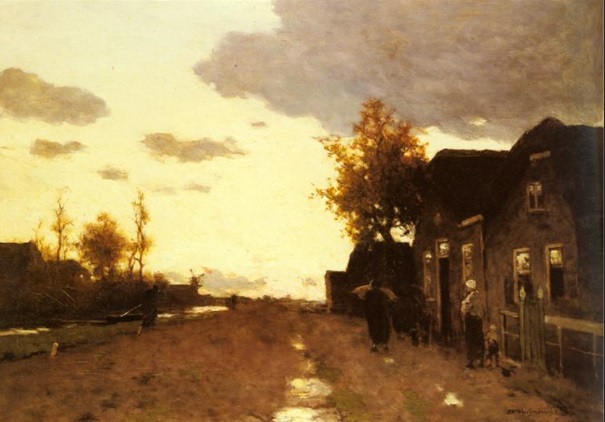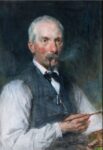
Hendrik Weissenbruch
Dutch, 1824-1903
Canal Near Noorden, Sunset, 1893
oil on board OR oil on canvas laid on board
34 1/2 x 50 in.
Private Collection

Jan Hendrik Weissenbruch, by Jozef Israëls (1882)
“And that J.H. Weissenbruch knows and does the muddy towpaths, the stunted willows, the foreshortenings and the learned and strange perspectives of the canals 'as Daumier does his lawyers’, I think that’s perfect.” - Letter to Theo, 10 September 1889
COMMENTS
Jan Hendrik Weissenbruch, whose Christian name was Hendrik Johannes, was born into a family of artists of which he and his cousin Jan (1822-1880) were the main representatives. In order to distinguish him from his cousin, who was almost the same age and painted with a plain technique and brilliant colors-above all city landscapes-Jan Hendrik was also known as "de vrolijke Weiss" (a play on words that means "the cheerful melody").
At the beginning of his career, Weissenbruch received drawing classes from Johannes Low for three years. Later on, he was trained by scenery painter Bart van Hove (1790-1880) and attended night classes at the Academy of the Hague. In 1849, two years after Weissenbruch staged his first exhibition, the Teylers Museum in Haarlem acquired one of his panoramic landscapes. However, that early success did not last very long. In spite of the prestige he had earned among his colleagues, he did not achieve public acknowledgement until the late 1880s.
During this intermediate period, Weissenbruch went from being a characteristic painter of Dutch Romanticism to one of the best representatives of the Hague School. His lively dune landscapes led to a series of atmospheric impressions of the Dutch polders, in which the artist paid special attention to his representation of the cloudy skies and stretches of water. These beautiful oil and watercolor landscapes were painted, almost without exception, with free and delicate brushstrokes.
- Marjan van Heteren
http://www.museothyssen.org/en/collection/artists/weissenbruch-jan-hendrik
Johannes Hendrik Weissenbruch spent his entire career in The Hague, mainly painting landscapes, engaged in a constant battle as he described it “to have nature itself on the canvas”. In Dr. Jos. De Gruyter’s 1968 standard-setting two volume work De Haagse School, he characterized Weissenbruch as “the greatest of the Hague School painters ... a landscapist par excellence with powers of suggestion beyond anything the 17th century has ever known. In him the development of the Hague School reached its culmination”.
Vincent Van Gogh first became aware of works by Weissenbruch in 1872 and met him in 1873. In a letter to his brother Theo dated August 3, 1877, Van Gogh recalled, “I was once at Weissenbruch’s studio, a few days before I left for London, and the memory of what I saw there, the studies and the pictures, is still as vivid as that of the man himself”. Most admired by Van Gogh was Weissenbruch’s play of light and shadow as well as his loose and vigorous brushwork, which are the compositional essence of “A Sunlit Windmill in the Dunes Near The Hague”. In this work under an endless vista of rolling clouds hovering over a flat landscape defined by alternating bands of light and shade, vertical accents are provided by the simplistic shapes of the farmhouse, windmill, clump of trees and haystacks. Combined with pleasing coloration, the panel is really a poetic evocation of nature as opposed to a topographical view. In its simplicity lies its modernity.
http://www.steigrad.com/weissenbruch-windmill
SBMA CURATORIAL LABELS
The landscapes of Weissenbruch, who hailed from a family of artists, typify the group of Dutch painters designated as the Hague School. Like the Barbizon school artists in France, this group was devoted to capturing the nuances of light, atmosphere, and scenery characteristic of Holland, and in Weissenbruch’s case, specifically the wetlands around Nieuwkoop and Noorden in southern Holland. Even before Van Gogh set foot in France, his penchant for landscape would have been shaped by paintings such as this one, which lingers on the delicate hues of the horizon, the silhouetted clouds, and the shimmering reflections of the watery canals native to Van Gogh’s Holland.
- Through Vincent's Eyes, 2022
